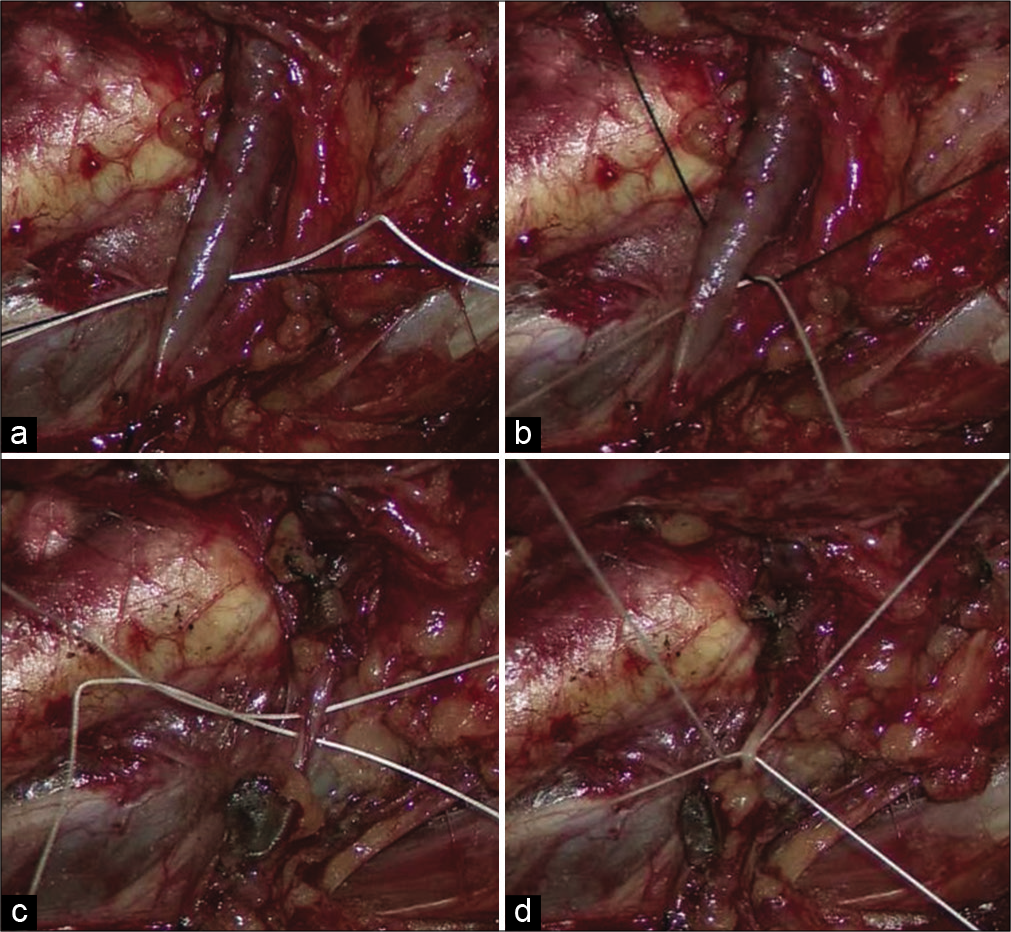- Department of Neurosurgery, Saiseikai Shiga Hospital, Imperial Gift Foundation Inc., Ritto, Shiga, Japan.
DOI:10.25259/SNI_642_2020
Copyright: © 2020 Surgical Neurology International This is an open-access article distributed under the terms of the Creative Commons Attribution-Non Commercial-Share Alike 4.0 License, which allows others to remix, tweak, and build upon the work non-commercially, as long as the author is credited and the new creations are licensed under the identical terms.How to cite this article: Shigeomi Yokoya, Akihiko Hino, Hideki Oka. Colored ligature: Trivial but innovative modification. 05-Jan-2021;12:3
How to cite this URL: Shigeomi Yokoya, Akihiko Hino, Hideki Oka. Colored ligature: Trivial but innovative modification. 05-Jan-2021;12:3. Available from: https://surgicalneurologyint.com/surgicalint-articles/10512/
Abstract
Background: Vascular ligation and its detachment remain a necessary skill for a surgeon. We often use two threads of the same color to ligate a vessel. However, some problems (grasping the mixed-up threads and/or difficulty in releasing the entanglement) may occur while using same colored ligatures. To solve these problems, we devised to use ligatures of different colors, and here, we present this ingenious idea.
Methods: When a vessel is encountered that needs to be cut, we pass two different colored threads behind it.
Results: We can grasp the two threads without mixing them up. In addition, in case of entanglement, unwinding of the entangled threads is quicker. We then finally tie a knot with these threads and cut the vessel visible between them.
Conclusion: Using different colored ligatures enhance surgical convenience in the operating room.
Keywords: Colored ligature, Surgical comfortability, Surgical skill, Vascular ligation
INTRODUCTION
Vascular ligation and division forms a fundamental surgical skill for a surgeon, since inadequate ligation of vasculature during surgical procedure could lead to clinically serious intra- or postoperative hemorrhagic complications.[
To the best of our knowledge, the use of different colored threads for ligation of vasculature and reducing the complexities and time taken for such procedures has not been described elsewhere. Very few studies have focused on ways to improve the visibility of surgical materials such as surgical threads or needles.[
ILLUSTRATIVE CASE
A 75-year-old man diagnosed with a symptomatic internal carotid artery stenosis underwent carotid endarterectomy to prevent recurrent stroke in our hospital. During the procedure, we identified several facial veins that crossed the surgical field. We dissected around the facial vein and passed two threads of different colors (white and black) behind the vein with a Peang mosquito [
Figure 1:
Intraoperative photographs of the illustrated case. (a) A photograph showing different colored ligatures passing behind the facial vein. We can instantly identify which ligature should be picked up. (b) A photograph showing the grasped ligatures in an entangled position. We can figure out the direction to follow to unwind the ligature. (c) A photograph showing same colored ligature passing behind the vessel. We could not identify which ligature should be picked up. (d) A photograph showing that the grasped ligatures entangled midway. We could not appreciate the direction to following order to unwind the ligature.
The white and black ligatures were grasped by the surgeon and the assistant respectively without mixing them up. Even if the grasped threads got entangled midway [
DISCUSSION
This small ingenuity of using different colored ligatures is advantageous. The surgeon and the assistant can instantly determine which thread should be grasped [
On the other hand, using the same colored ligature, we could not determine in which direction to move so as to unwind the entangled ligature. This often would make matters worse by causing more entanglement [
Of course, in practice, the surgical time saved by this ingenuity is trivial. However, such trivial ingenuities are necessary for a surgeon to proceed without getting irritated.
CONCLUSION
Using different colored threads improve surgeon comfort during surgery.
Ethical approval
The publication of this case report was approved by the Ethics Committee of Saiseikai Shiga Hospital (Permission number: 402).
Declaration of patient consent
Institutional Review Board permission obtained for the study.
Financial support and sponsorship
Nil.
Conflicts of interest
There are no conflicts of interest.
References
1. Karmody A, Leather R, Shah D, Corson J. The development of a high visibility needle. Contemp Surg. 1987. 31: 48-50
2. McKernan JB, Bendel L, Freeman L, Cafferty D. Improved visibility of black surgical needles in laparoscopic surgery. Surg Endosc. 1993. 7: 424-6
3. Shaver SL, Yamada N, Hofmeister EH. In vitro security of 3 surgical knots placed by novice veterinary students. Vet Surg. 2019. 48: 209-15
4. Storozhuk VT, Vol’f LA, Kalinina TN, Zhukovskiĭ VA, Amrenov MT, Imangazinov SB. Use of polypropylene single thread as the suture material. Khirurgiia (Mosk). 1991. 12: 132-5






